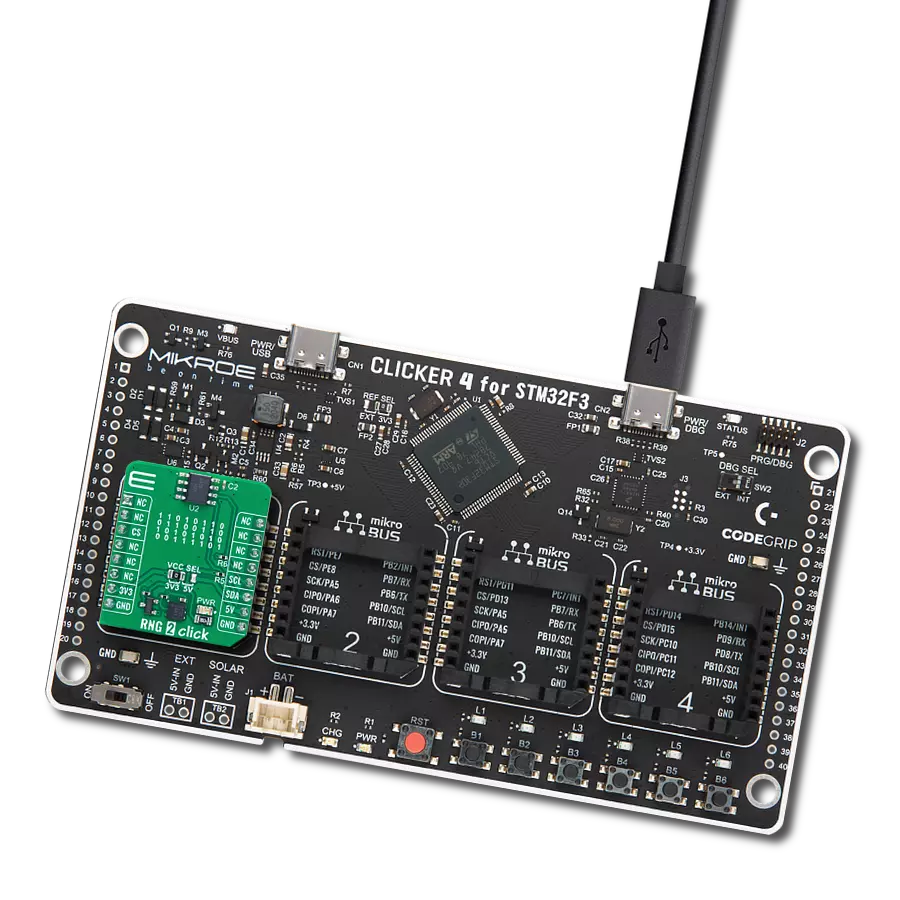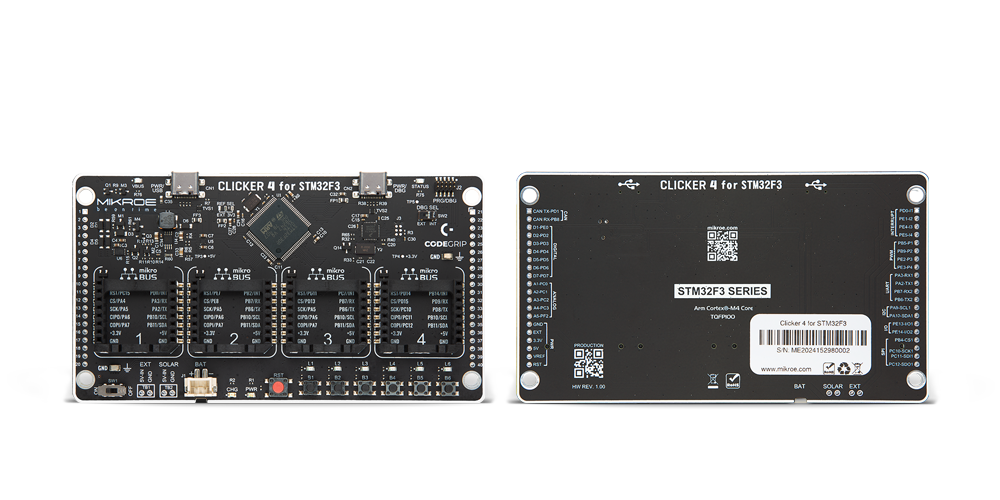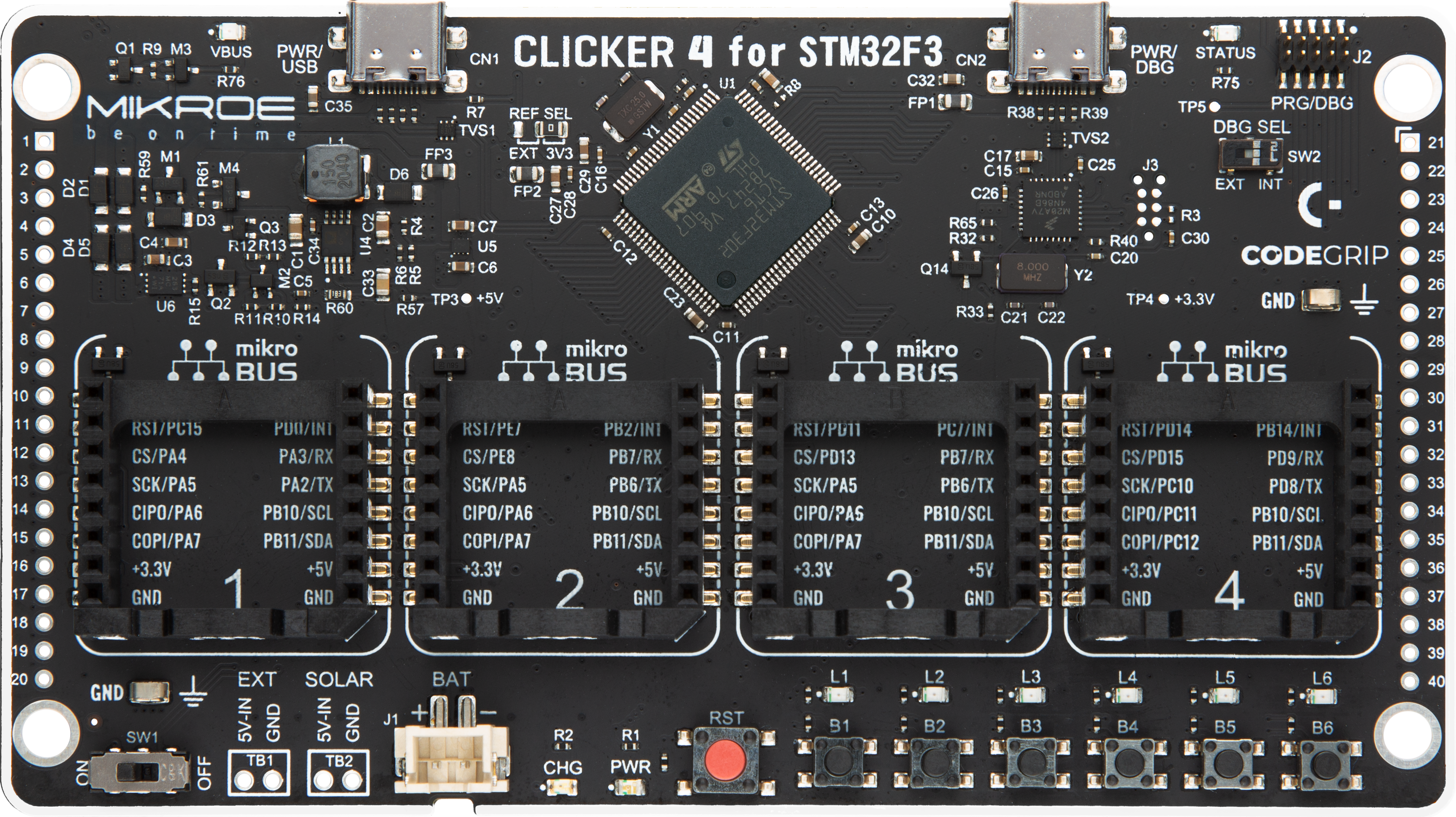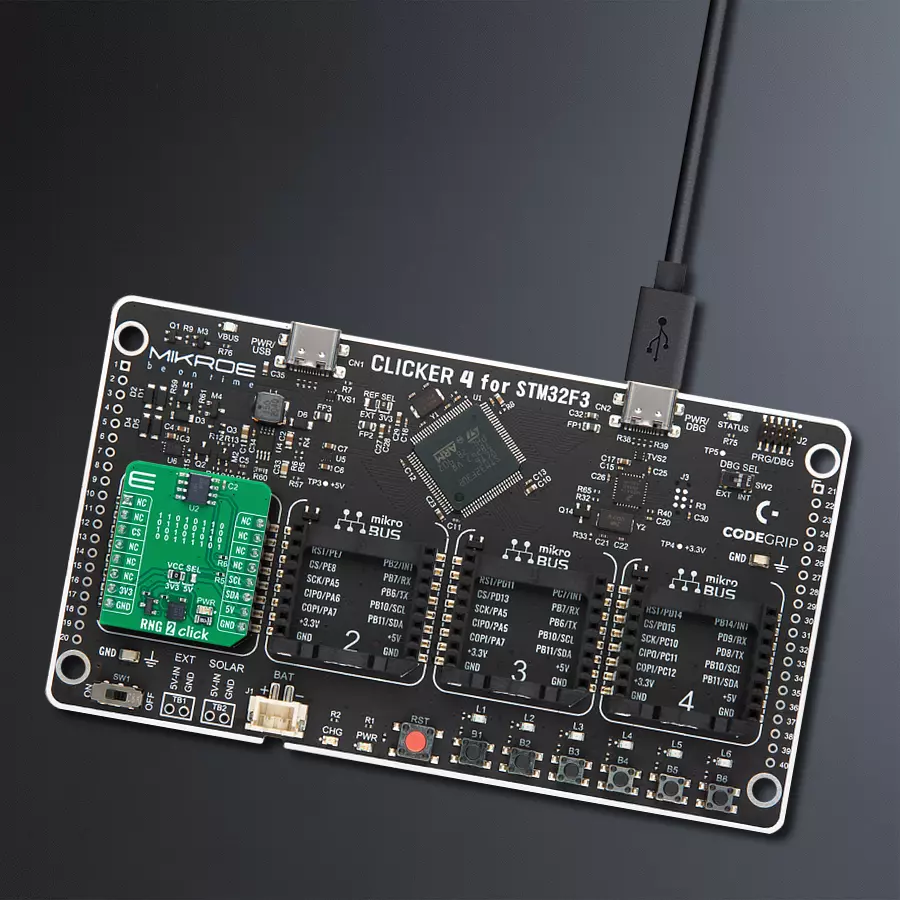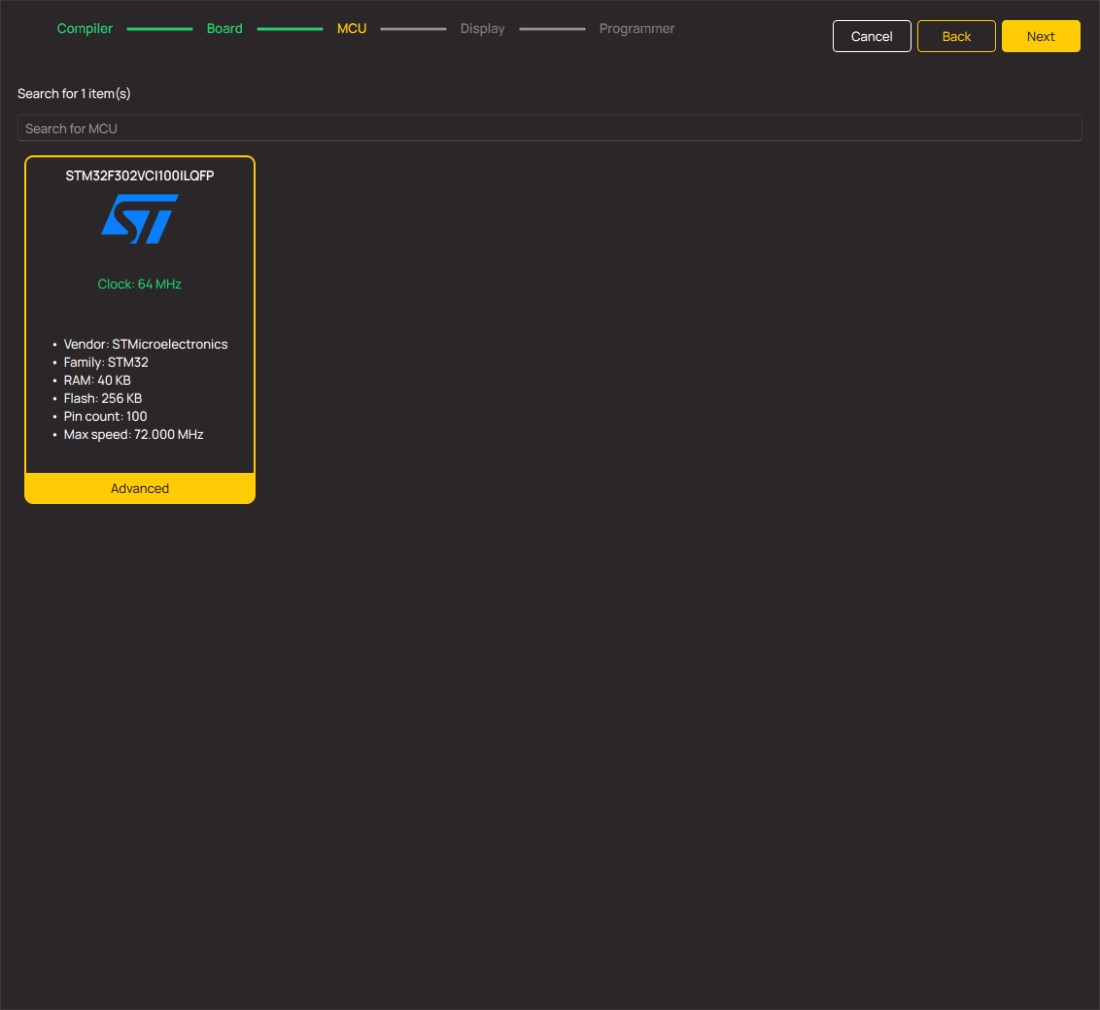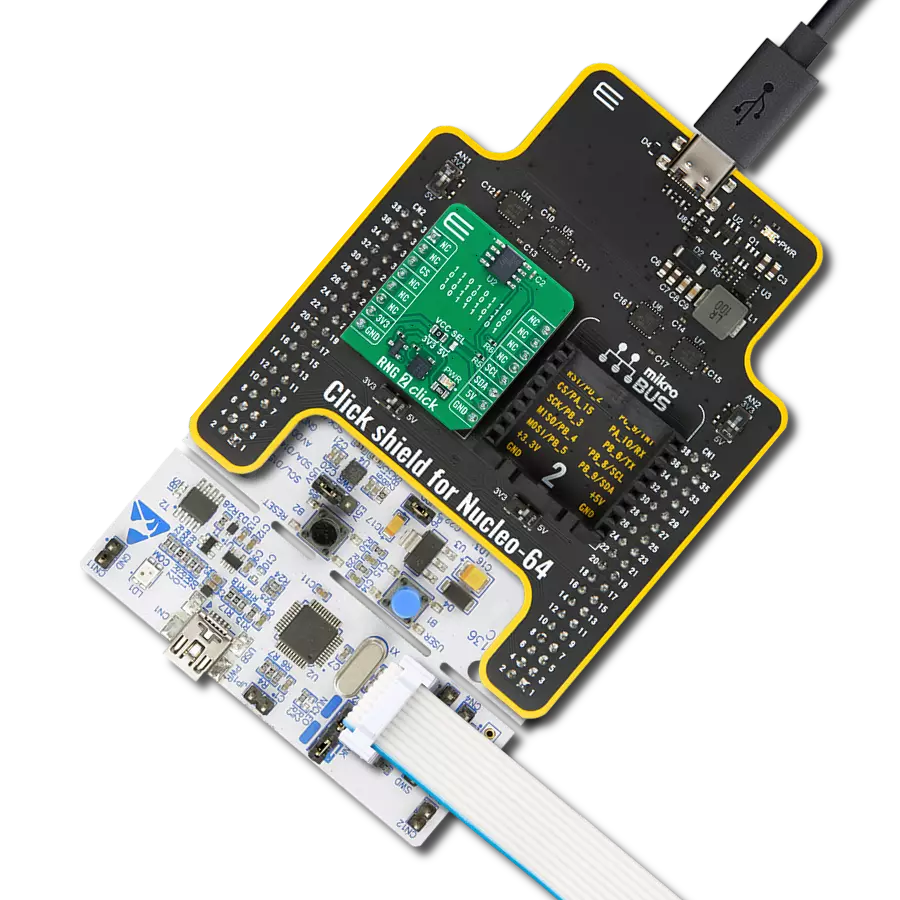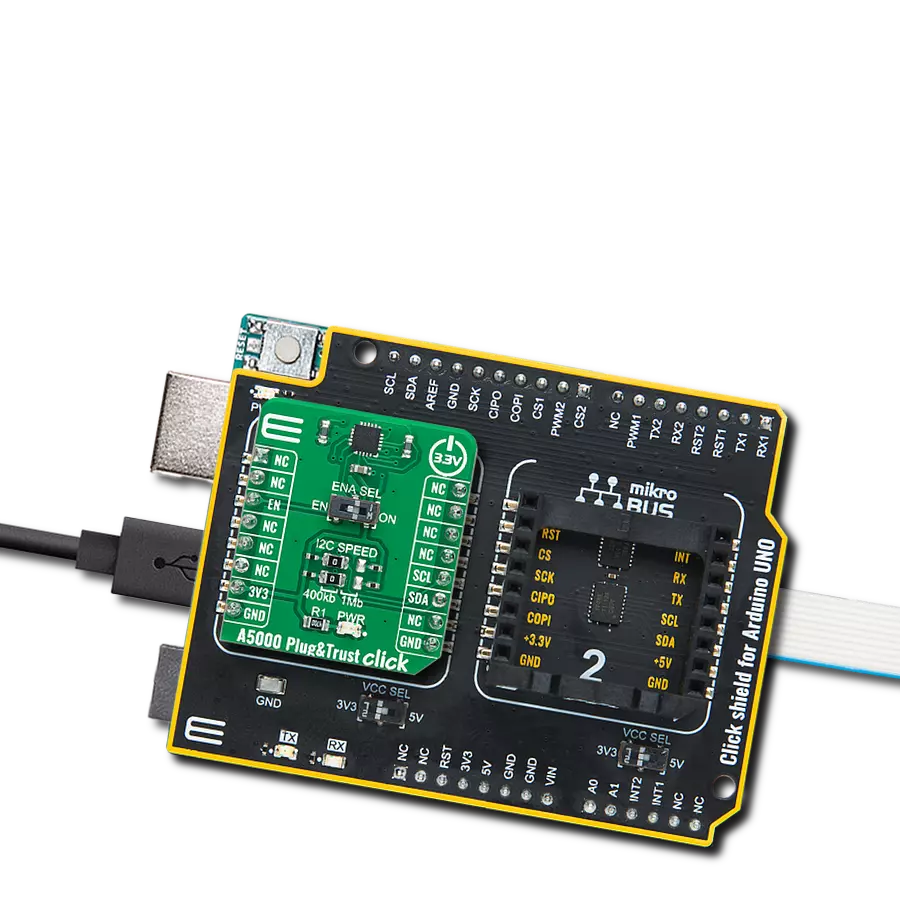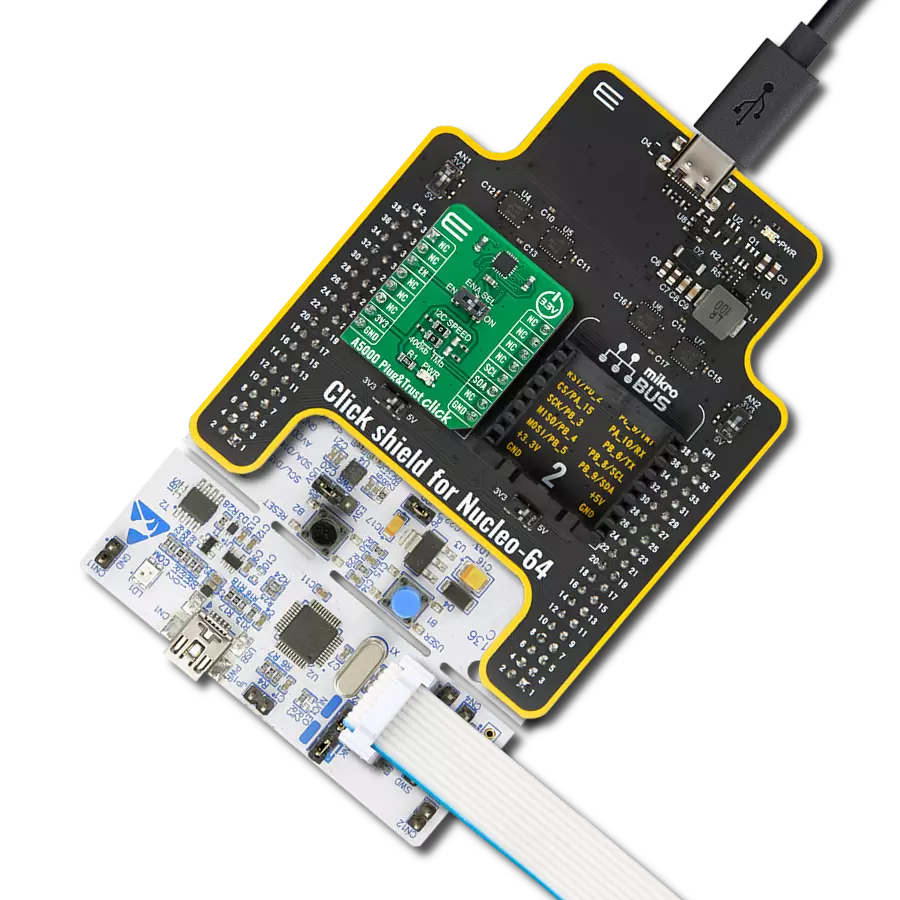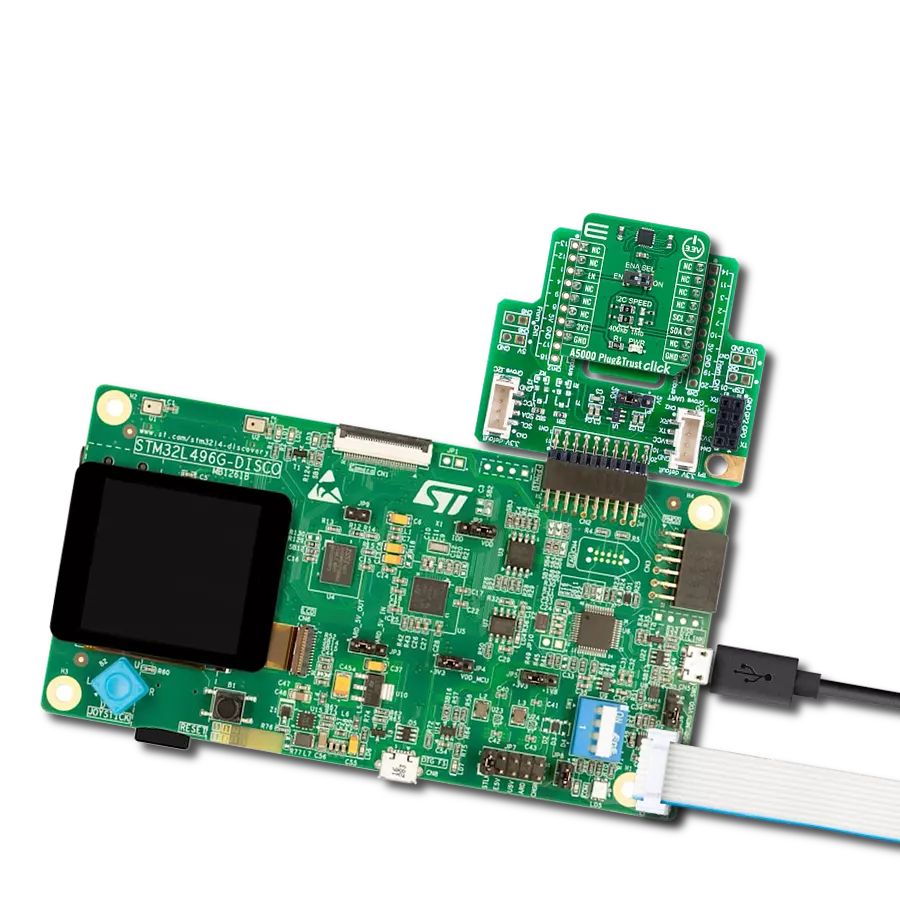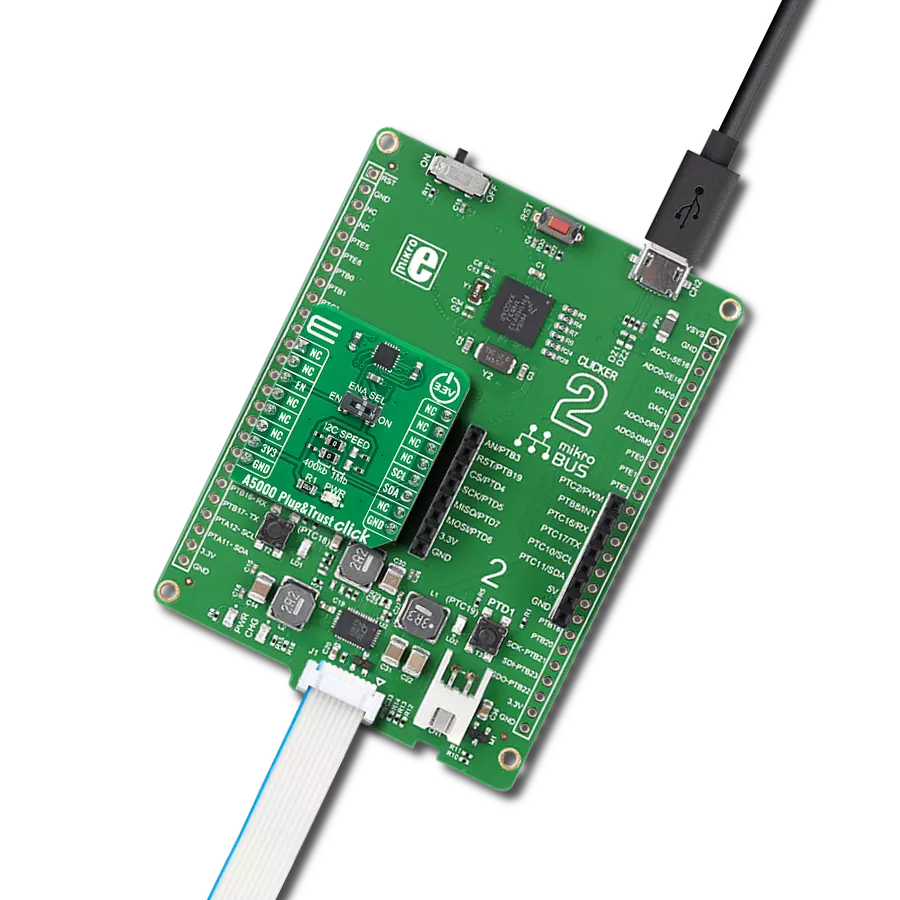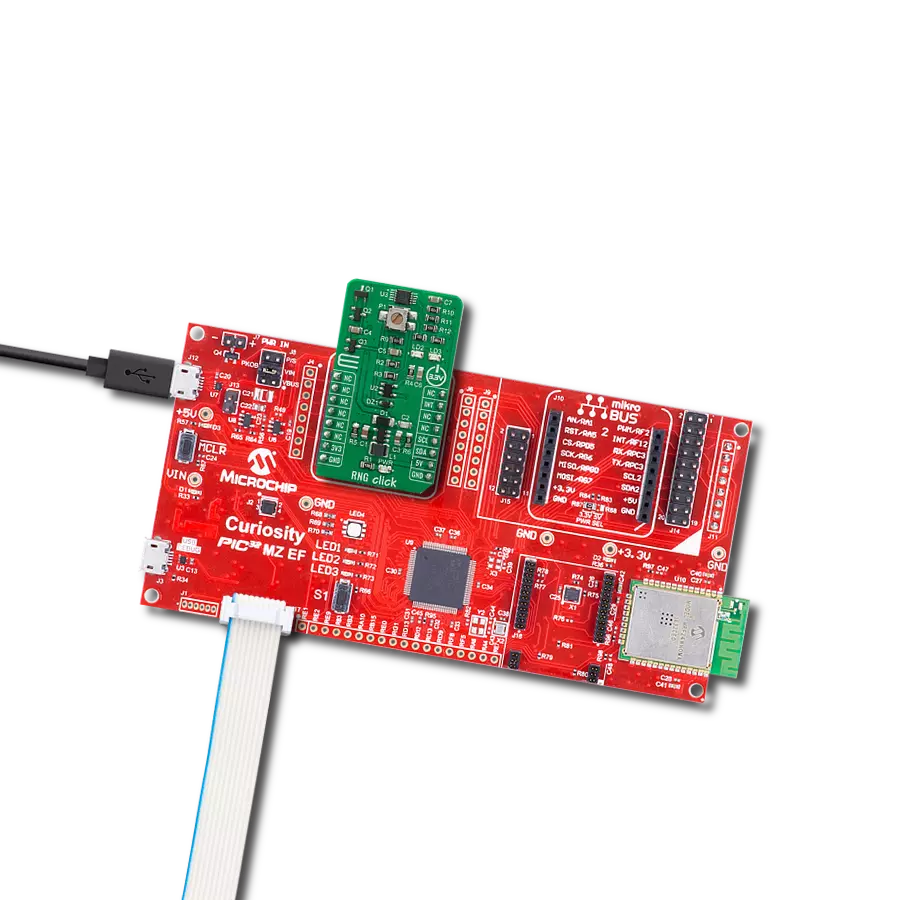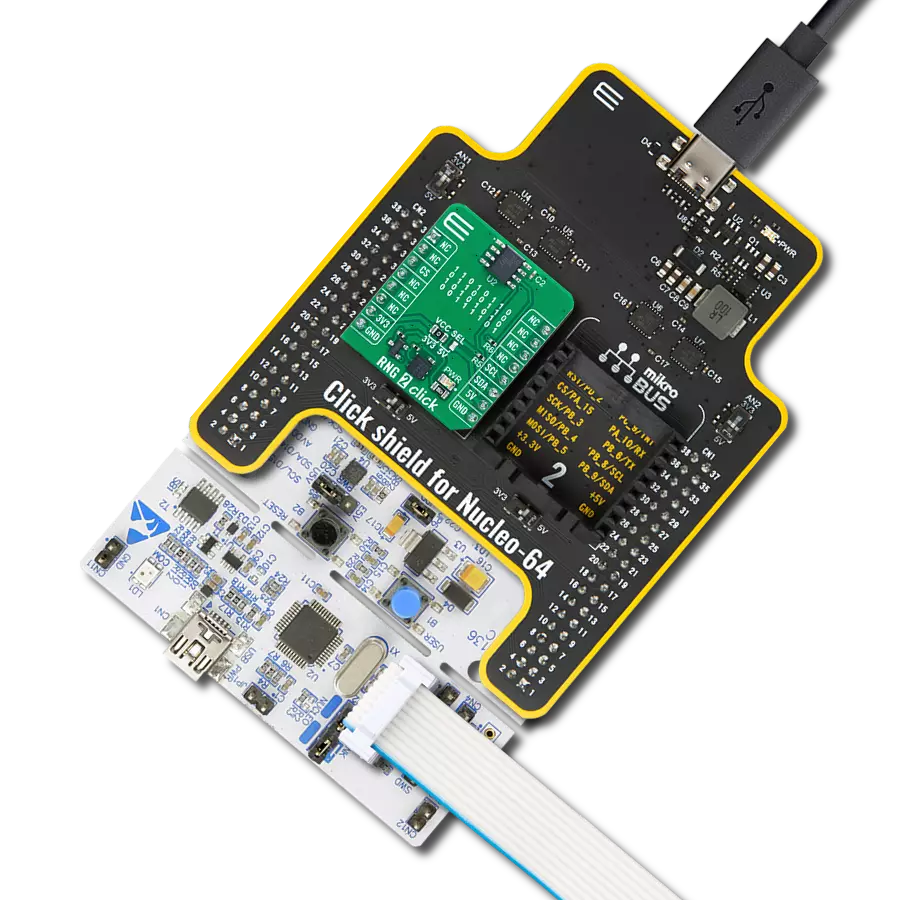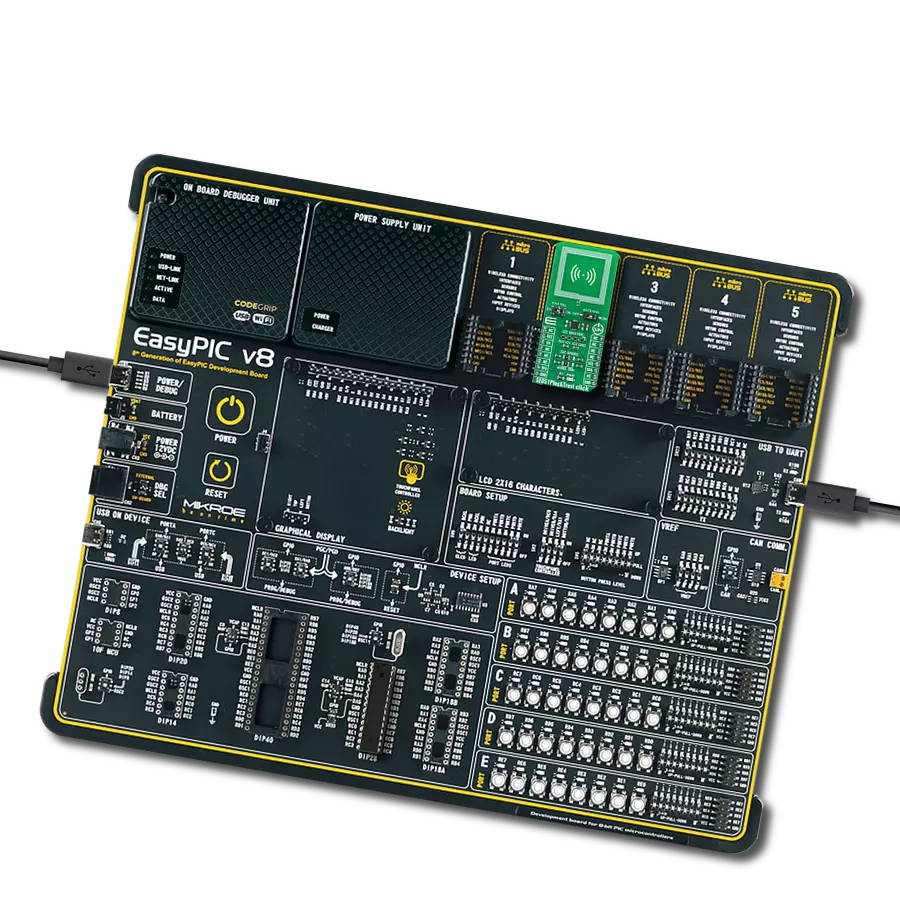Secure, NIST-certified 256-bit random number generation with tamper detection
A
A
Hardware Overview
How does it work?
RNG 2 Click is based on the RNG90, a secure Random Number Generator (RNG) from Microchip fully compliant with the NIST SP 800-90A/B/C standards. This Click board™ is designed to meet the stringent requirements of modern cryptographic systems, where the strength of generated random numbers directly influences the overall system security. True random number generation is critical in cryptographic applications such as key generation, digital signatures, password creation, nonce generation, random challenges, and initialization vectors. The RNG90 IC addresses these needs by producing a 256-bit random number with each Random command execution, offering a robust security strength of 128 bits. Independently
validated for randomness through a NIST-certified laboratory, the RNG90 guarantees trustworthy operation in sensitive applications. As part of Microchip’s CryptoAuthentication™ product line, it integrates into systems demanding secure, ready-to-use randomness without requiring any additional configuration. RNG 2 Click communicates over a standard I2C interface operating at up to 400kHz, making it simple to integrate with a wide range of host MCUs. It also features a unique 72-bit serial number and advanced hardware-based security mechanisms such as an active shield for protection against invasive physical attacks, tamper detection for abnormal voltage conditions, and temperature-based tamper monitoring. With these features,
RNG 2 Click is ideally suited for use in cryptographic systems, password management tools, gaming platforms, cryptocurrency hardware wallets, scientific experiments, and even aerospace and defense technologies, where secure and certified random number generation is a fundamental requirement. This Click board™ can operate with either 3.3V or 5V logic voltage levels selected via the VCC SEL jumper. This way, both 3.3V and 5V capable MCUs can use the communication lines properly. Also, this Click board™ comes equipped with a library containing easy-to-use functions and an example code that can be used as a reference for further development.
Features overview
Development board
Clicker 4 for STM32F3 is a compact development board designed as a complete solution, you can use it to quickly build your own gadgets with unique functionalities. Featuring a STM32F302VCT6, four mikroBUS™ sockets for Click boards™ connectivity, power managment, and more, it represents a perfect solution for the rapid development of many different types of applications. At its core, there is a STM32F302VCT6 MCU, a powerful microcontroller by STMicroelectronics, based on the high-
performance Arm® Cortex®-M4 32-bit processor core operating at up to 168 MHz frequency. It provides sufficient processing power for the most demanding tasks, allowing Clicker 4 to adapt to any specific application requirements. Besides two 1x20 pin headers, four improved mikroBUS™ sockets represent the most distinctive connectivity feature, allowing access to a huge base of Click boards™, growing on a daily basis. Each section of Clicker 4 is clearly marked, offering an intuitive and clean interface. This makes working with the development
board much simpler and thus, faster. The usability of Clicker 4 doesn’t end with its ability to accelerate the prototyping and application development stages: it is designed as a complete solution which can be implemented directly into any project, with no additional hardware modifications required. Four mounting holes [4.2mm/0.165”] at all four corners allow simple installation by using mounting screws. For most applications, a nice stylish casing is all that is needed to turn the Clicker 4 development board into a fully functional, custom design.
Microcontroller Overview
MCU Card / MCU
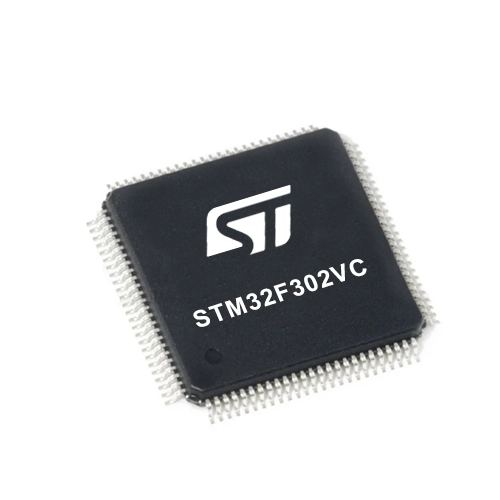
Architecture
ARM Cortex-M4
MCU Memory (KB)
256
Silicon Vendor
STMicroelectronics
Pin count
100
RAM (Bytes)
40960
Used MCU Pins
mikroBUS™ mapper
Take a closer look
Click board™ Schematic
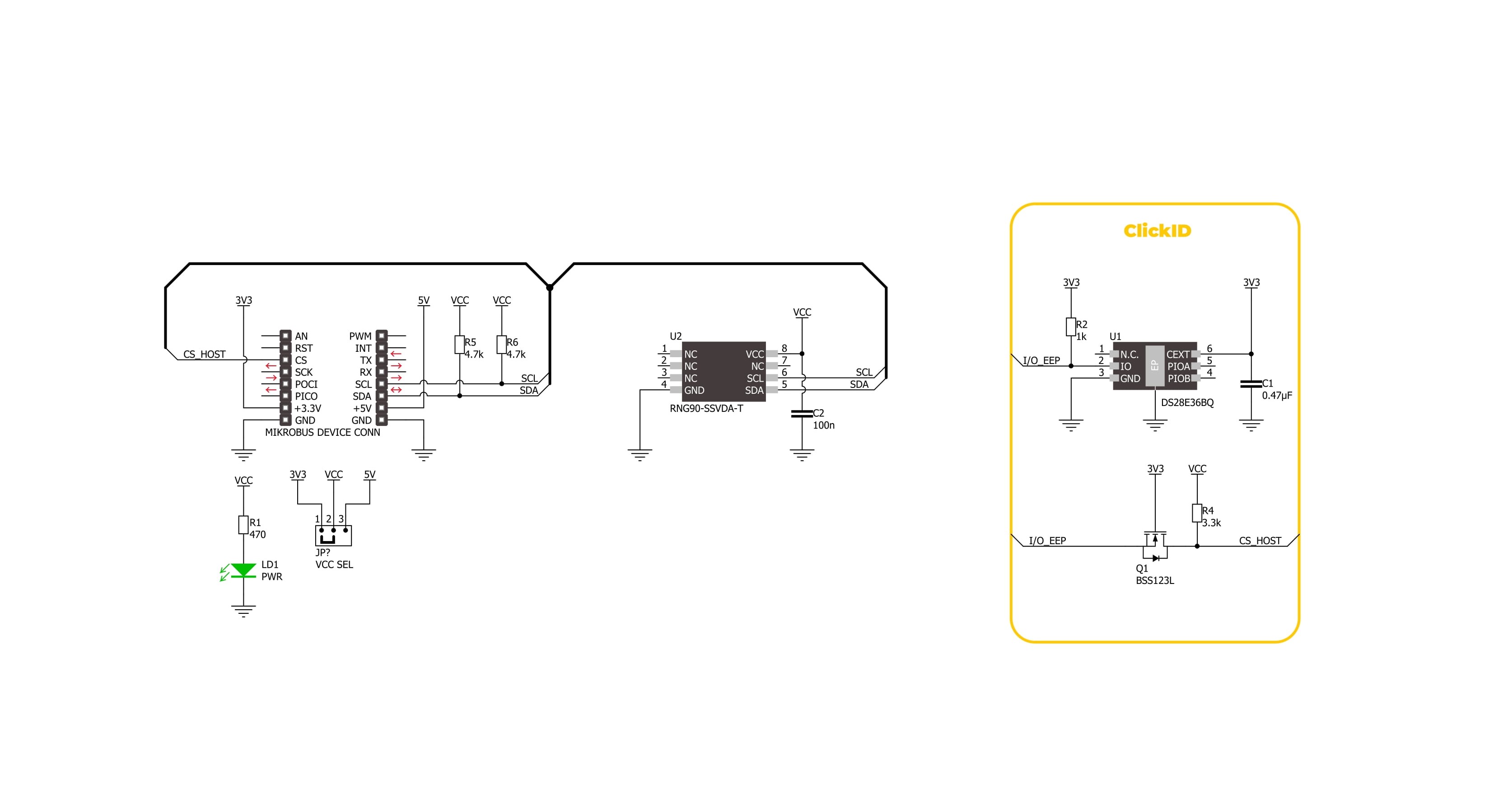
Step by step
Project assembly
Software Support
Library Description
RNG 2 Click demo application is developed using the NECTO Studio, ensuring compatibility with mikroSDK's open-source libraries and tools. Designed for plug-and-play implementation and testing, the demo is fully compatible with all development, starter, and mikromedia boards featuring a mikroBUS™ socket.
Example Description
This example demonstrates the use of the RNG 2 Click board by periodically reading and logging random numbers generated by the device.
Key functions:
rng2_cfg_setup- This function initializes Click configuration structure to initial values.rng2_init- This function initializes all necessary pins and peripherals used for this Click board.rng2_default_cfg- This function executes a default configuration of RNG 2 Click board.rng2_read_random_num- This function requests and reads a 32-byte random number from the RNG 2 Click board.
Application Init
Initializes the logger and the Click board driver, then applies the default configuration.
Application Task
Reads and displays a 32-byte random number from the device every second.
Open Source
Code example
The complete application code and a ready-to-use project are available through the NECTO Studio Package Manager for direct installation in the NECTO Studio. The application code can also be found on the MIKROE GitHub account.
/*!
* @file main.c
* @brief RNG 2 Click example
*
* # Description
* This example demonstrates the use of the RNG 2 Click board by periodically reading
* and logging random numbers generated by the device.
*
* The demo application is composed of two sections :
*
* ## Application Init
* Initializes the logger and the Click board driver, then applies the default configuration.
*
* ## Application Task
* Reads and displays a 32-byte random number from the device every second.
*
* @author Stefan Filipovic
*
*/
#include "board.h"
#include "log.h"
#include "rng2.h"
static rng2_t rng2;
static log_t logger;
void application_init ( void )
{
log_cfg_t log_cfg; /**< Logger config object. */
rng2_cfg_t rng2_cfg; /**< Click config object. */
/**
* Logger initialization.
* Default baud rate: 115200
* Default log level: LOG_LEVEL_DEBUG
* @note If USB_UART_RX and USB_UART_TX
* are defined as HAL_PIN_NC, you will
* need to define them manually for log to work.
* See @b LOG_MAP_USB_UART macro definition for detailed explanation.
*/
LOG_MAP_USB_UART( log_cfg );
log_init( &logger, &log_cfg );
log_info( &logger, " Application Init " );
// Click initialization.
rng2_cfg_setup( &rng2_cfg );
RNG2_MAP_MIKROBUS( rng2_cfg, MIKROBUS_1 );
if ( RNG2_OK != rng2_init( &rng2, &rng2_cfg ) )
{
log_error( &logger, " Communication init." );
for ( ; ; );
}
if ( RNG2_ERROR == rng2_default_cfg ( &rng2 ) )
{
log_error( &logger, " Default configuration." );
for ( ; ; );
}
log_info( &logger, " Application Task " );
}
void application_task ( void )
{
if ( RNG2_OK == rng2_read_random_num ( &rng2 ) )
{
log_printf ( &logger, " Random number: " );
for ( uint8_t cnt = 0; cnt < rng2.rsp_pkt.data_len; cnt++ )
{
log_printf ( &logger, "%.2X", ( uint16_t ) rng2.rsp_pkt.data_buf[ cnt ] );
}
log_printf ( &logger, "\r\n\n" );
}
Delay_ms ( 1000 );
}
int main ( void )
{
/* Do not remove this line or clock might not be set correctly. */
#ifdef PREINIT_SUPPORTED
preinit();
#endif
application_init( );
for ( ; ; )
{
application_task( );
}
return 0;
}
// ------------------------------------------------------------------------ END
Additional Support
Resources
Category:Encryption
